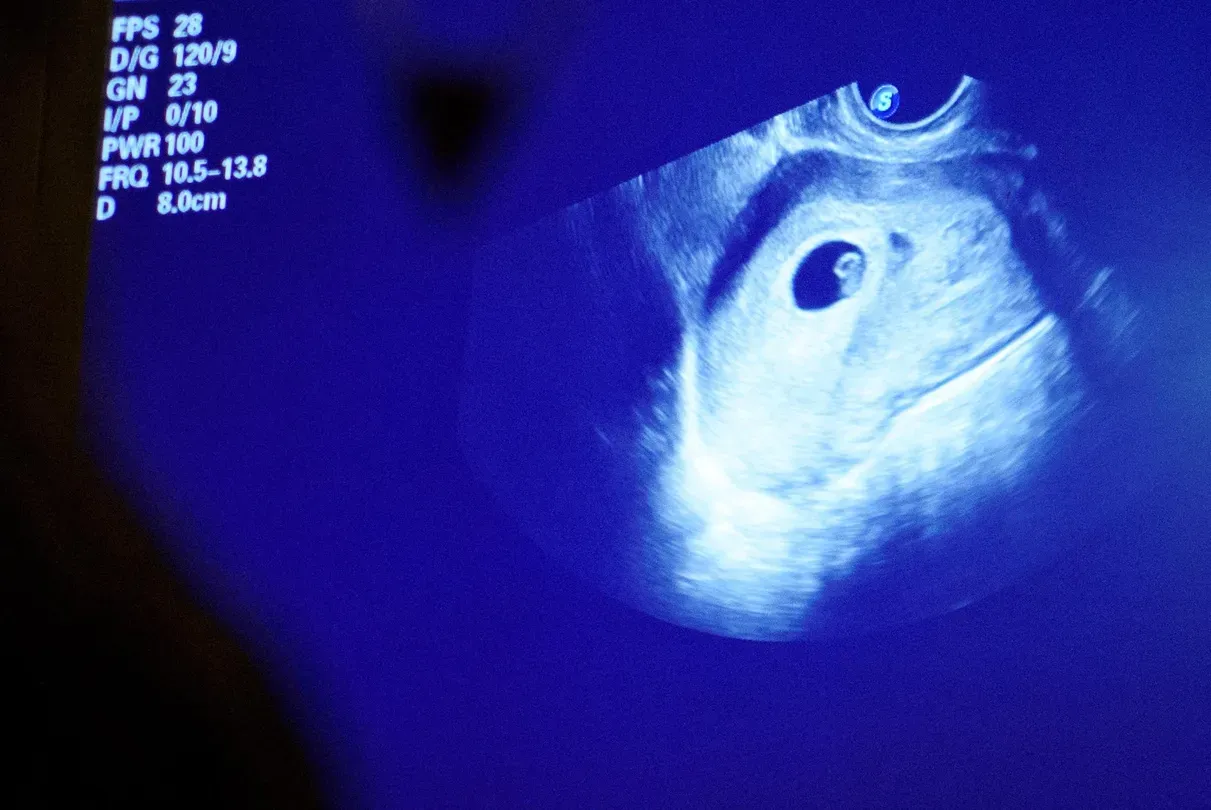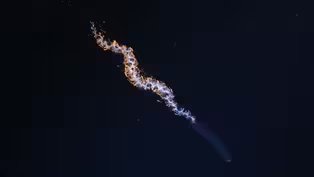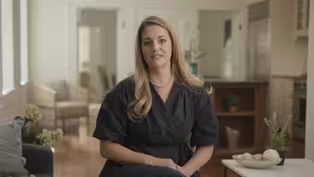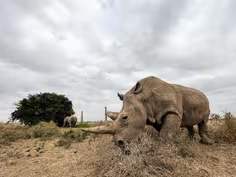

March 2, 2024 - PBS News Weekend full episode
3/2/2024 | 24m 8sVideo has Closed Captions
March 2, 2024 - PBS News Weekend full episode
Saturday on PBS News Weekend, why support for crisis pregnancy centers is surging after the Supreme Court struck down Roe v. Wade. Then, with only two northern white rhinos left in the world, how a potential scientific breakthrough may help save the species from extinction. Plus, how a grieving mother was inspired to create an organization to provide bereavement care for families and children.
Problems playing video? | Closed Captioning Feedback
Problems playing video? | Closed Captioning Feedback
Major corporate funding for the PBS News Hour is provided by BDO, BNSF, Consumer Cellular, American Cruise Lines, and Raymond James. Funding for the PBS NewsHour Weekend is provided by...

March 2, 2024 - PBS News Weekend full episode
3/2/2024 | 24m 8sVideo has Closed Captions
Saturday on PBS News Weekend, why support for crisis pregnancy centers is surging after the Supreme Court struck down Roe v. Wade. Then, with only two northern white rhinos left in the world, how a potential scientific breakthrough may help save the species from extinction. Plus, how a grieving mother was inspired to create an organization to provide bereavement care for families and children.
Problems playing video? | Closed Captioning Feedback
How to Watch PBS News Hour
PBS News Hour is available to stream on pbs.org and the free PBS App, available on iPhone, Apple TV, Android TV, Android smartphones, Amazon Fire TV, Amazon Fire Tablet, Roku, Samsung Smart TV, and Vizio.
Providing Support for PBS.org
Learn Moreabout PBS online sponsorshipJOHN YANG: Tonight on PBS News Weekend, a look at the surge in support for crisis pregnancy centers across the country since the Supreme Court struck down Roe versus Wade, then with only two remaining northern white rhinos in the world, a potential scientific breakthrough may help save the species from extinction.
WOMAN: We are in the midst of an extinction crisis.
And we should be looking for all of the different potential tools that might be out there for us to be able to help species that are alive today and in danger of becoming extinct to avoid that fate.
JOHN YANG: And how a grieving mother was inspired to create her own organization to provide bereavement care for families and children.
(BREAK) JOHN YANG: Good evening, I'm John Yang.
Tonight, U.S. officials say Israeli leaders have essentially agreed to a proposal for a six week ceasefire in Gaza and the release of some hostages.
All that's left is for Hamas to agree to it.
Talks to resume tomorrow in Cairo.
In Gaza, three USC 130s dropped 38,000 meals onto the beaches of Southwest Gaza.
More deliveries are expected in coming days from the United States, Egypt and Jordan.
And in the Red Sea a ship hit by a Houthi missile two weeks ago has sunk the first vessel to be destroyed by Houthi attacks.
The Belize flagged Ruby Mar was carrying tons of fertilizer.
Yemeni officials call the sinking an unprecedented environmental disaster.
Fire and ice in two states tonight, firefighters in Texas Panhandle are battling the largest wildfire in the state's history in increasingly difficult weather conditions.
Since Monday, the fire has killed at least two people, scorch 1,700 square miles of prairie, destroyed as many as 500 structures and killed thousands of cattle.
In the mountains of northern California and Nevada, the biggest storm of the season is closed 100 miles of Interstate 80 and knocked out power to tens of thousands of homes up to 10 feet of snow is forecast for higher elevations.
Donald Trump won the Missouri Republican caucuses today continuing his string of early contest victories.
In Michigan, Trump won all 39 delegates awarded by today's state party convention.
Idaho Republicans hold their caucuses tonight, tomorrow begins a three day series of 17 contests including Super Tuesday, when almost two-thirds of all delegates are up for grabs.
Trump's last major rival Nikki Haley has yet to win any primary or caucus.
At a self-described geriatric starlet fashion icon Iris Apfel has died.
She was a textile expert, an interior designer and a late in life fashion model in her 80s and 90s with an eye catching and audaciously clashing style.
She was the subject of several museum exhibitions, a documentary and major ad campaigns.
She even let her expertise to the White House working on restoration projects under nine different presidents Iris Apfel was 102.
Still to come on PBS News Weekend, scientific breakthroughs give hope to save the northern white rhino from extinction.
And a Brief But Spectacular take on the importance of bereavement care.
(BREAK) JOHN YANG: Crisis pregnancy centers provide counseling and other prenatal services from an anti-abortion perspective.
Their supporters say they help ensure that pregnant people know the risks of abortion.
Advocates of abortion rights say the information they provide can be misleading or have no scientific basis.
As Ali Rogin reports there's a debate over federal aid for these facilities.
ALI ROGIN: In the United States, so called crisis pregnancy centers are nothing new.
The first one opened in Hawaii more than 50 years ago.
But after the Supreme Court ended the constitutional right to an abortion, these largely unregulated centers have seen renewed support and attention.
According to analysis by the group reproductive health and freedom watch, which supports abortion rights, anti-abortion pregnancy centers brought in at least $1.4 billion in revenue in the 2022 fiscal year.
That includes at least $344 million in government grants.
There are an estimated 2,500 such pregnancy centers around the country.
In comparison about 800 clinics providing abortion care, were operating before the Supreme Court overturned Roe v. Wade.
Carter Sherman is reproductive health and justice reporter for The Guardian.
Thank you so much, Carter, for joining us.
Tell us a little bit about how these centers work, what sorts of services do they provide.
CARTER SHERMAN, The Guardian: So the point of a crisis pregnancy center, which is often known as a anti-abortion center, or even just a pregnancy center, is to convince people to continue their pregnancies.
And they offer services like pregnancy tests, they sometimes do medical services like ultrasounds, they will also give out goods like car seats or strollers.
Now the thing is that even when they do provide these medical services, many of these facilities are not actually medically licensed.
So they're not burdened by the kind of limitations that medical providers face.
The other thing about these centers is that they're often staffed by volunteers, they're usually faith based.
And so that creates issues for courts that might be looking to further regulate them, because judges are very wary of treading on these centers first amendment rights.
ALI ROGIN: So when someone does enter one of these crisis pregnancy centers, what sort of interactions are they likely to have with these volunteers?
CARTER SHERMAN: I think the interactions can really vary a lot.
But something that has come up again and again, from people who go into these centers is that they walk in not necessarily knowing that they are not in an abortion clinic.
You know, these centers, according to abortion rights supporters will oftentimes set up shop very close to an abortion clinic, they will have names that include words like birth, or choice are the sorts of things that we tend to hear from abortion rights supporters.
And in reality, again, these are centers that are trying to convince you to continue a pregnancy.
ALI ROGIN: What sort of people do centers like these target?
CARTER SHERMAN: These centers offer usually free services.
And so that can be really appealing to people who are low income.
And we do know that at least prior to the overturning of Roe, most people who get abortions are low income, because it is so difficult for people to afford pregnancies in this country.
ALI ROGIN: So why are the centers receiving more funding now?
CARTER SHERMAN: Well, since the overturning of Roe v. Wade, the anti-abortion movement has really framed crisis pregnancy centers as the place to go for women who might otherwise have wanted an abortion but are now in a situation where they have little choice but to give birth.
And state governments, particularly the governments of red states have really agreed with that logic.
We know for example, that since the overturning of Roe v. Wade, at least 16 state governments have sent more than $250 million worth of taxpayer money to programs that support crisis pregnancy centers.
I think in the coming years, we're likely going to be seeing even more funding.
ALI ROGIN: So tell us a little bit more about the breakdown of what we do you know now about how these crisis centers are getting their funding.
Is it coming from the federal government, state and local governments?
What does that allocation look like?
CARTER SHERMAN: It can really be a mixture.
Some of the money that flows from the government to these crisis pregnancy centers is ultimately from the federal government.
We know that the state governments will take the money that the federal government gives them for things like Temporary Assistance to Needy Families and direct that towards programs to support crisis pregnancy centers.
ALI ROGIN: And there's now a debate happening between the White House and Congress over whether Temporary Assistance for Needy Families should continue to be used for crisis centers.
What is the status of that debate?
CARTER SHERMAN: Temporary Assistance for Needy Families is a program that we would tend to understand as being a part of welfare.
It is money that the federal government will give to state governments that they can then disperse for various aims to help families that are in trouble.
And one of the goals of temporary assistance for needy families or TANF is to help prevent out of wedlock pregnancies.
Now, the Biden administration has said that, you know, by the time someone comes to a crisis pregnancy center or they already suspected they're pregnant.
And so it's actually not an aim of a crisis pregnancy center to prevent an out of wedlock pregnancy because the pregnancy has already occurred.
The Biden administration introduced this rule.
The Republicans in the U.S. House have responded with legislation that would block HHS from effectively making that role.
That bill did pass the House but given Congress's general state of inaction and polarization right now, it is very unlikely that that bill will ultimately become law.
ALI ROGIN: Right, likely something we're going to see continue in state houses though.
Carter Sherman, reproductive health and justice reporter for The Guardian, thank you so much for joining us.
CARTER SHERMAN: Thank you for having me.
JOHN YANG: The northern white rhino was one of the world's biggest land mammals and one of the most endangered only two are known to be alive both female, but scientific breakthroughs are raising hopes for saving the rhino and perhaps even bringing other animals back from extinction.
This report is part of our series Saving Species.
JOHN YANG (voice-over): With the last known male northern white rhino in existence, named Sudan died in 2018 it seemed the future of the entire species died with him.
Like many endangered species, their population has been devastated by human activity, widespread poaching and civil wars and their native Central Africa.
Today, only two females remain Najin and Fatu, both living in a conservancy in Kenya.
But a recent scientific breakthrough has raised hopes for the northern white rhinos survival.
THOMAS HILDEBRANDT, Leibniz Institute For Zoo and Wildlife Research: The shift together, something which was not believed to be possible.
JOHN YANG (voice-over): Thomas Hildebrandt leads a team that successfully implanted a rhinoceros embryo into a surrogate mother.
Until now a tricky proposition giving the rhinoceros is two tongue size.
The embryo and mother were southern white rhinos, a close relative of the Northern subspecies,.
THOMAS HILDEBRANDT: What we have to do is mimicking nature, and to learn from nature and mimicking it and that worked quite well.
And I never lost my task that we will be successful.
JOHN YANG (voice-over): Now the team plans to use northern white rhino eggs and sperm that was harvested years ago from living male rhinos to continue the species because of age and health problems neither Najin or Fatu were able to carry pregnancies, which lasts about 16 months.
So the embryos will again be carried by Southern white rhinos.
Hildebrandt hopes a female can give birth to a calf within the next two years in order to preserve a crucial element that can't be replicated in a lab.
THOMAS HILDEBRANDT: If you want to save this social heritage, and therefore we need to let a calf which can learn the language from this last tool of their kind.
The genes are important, yes, but behavior is something which also needs to be conserved.
Otherwise, you're -- you end up as a nutrient, an animal that does not know what it actually is.
JOHN YANG (voice-over): But the northern white rhinos conceived this way won't have the genetic diversity needed to sustain a healthy population.
So Hildebrandt and his team are working with a US based genetic engineering firm called colossal Biosciences to use stem cells and gene editing technology to bridge the gap.
THOMAS HILDEBRANDT: If you want to introduce these individuals to the wild, they should have a wide variety of genes to fight against diseases, environmental factors, so there should not be an in breeding group.
That should be a healthy genetic population, but it's a quite holistic approach, which will take maybe decades to fulfill it.
However, it is a very pioneering concept, which gives a lot of hope for typical endangered species.
JOHN YANG (voice-over): Other scientists using genetic technology in an attempt to reintroduce or de extinct the dodo bird, the dodo was first seen around 1600 on the island of Mauritius in the Indian Ocean.
It became extinct less than 80 years later due to deforestation, hunting and destruction of their nests by animals introduced by Dutch settlers.
Beth Shapiro has spent 25 years studying the dodo.
She's an evolutionary biologist at the University of California, Santa Cruz, and an advisor to colossal biosciences.
BETH SHAPIRO, University of California, Santa Cruz: I became increasingly captivated by trying to figure out what it was about the dodo that made it so susceptible to becoming extinct, but also really to learn more about this iconic species so that we could potentially just really bring more attention to the fact that people are causing extinctions today.
JOHN YANG: Shapiro says the reintroduced dodo won't be exactly the same as the pre extinction birds.
BETH SHAPIRO: Identical copies of things are never going to happen.
But that's not the way evolution works anyway.
If we think about de extinction in a logical, ethical, ecologically sustainable way, it can't be this purist ideal of what the extinction means.
Instead, it has to be this creation of something new that's adapted for the for the habitat of today, and yet can potentially fill this, this void.
JOHN YANG: In 2000, Shapiro took DNA samples from the only known surviving soft tissue of a Dodo, housed in Oxford University's Museum of Natural History.
That led to the discovery that the dodo's closest living relative is the Nicobar pigeon, found in parts of Southeast Asia.
Using another dodo DNA sample from Copenhagen's natural history museum, Shapiro and her team were able to announce in March 2022, that they had sequenced the dodo's entire genome.
BETH SHAPIRO: If we want to know what makes a dodo unique, we have to have the whole nuclear genome sequence, the whole genome sequence, which we can then line up next to the genome sequences from other birds on a computer and start to look for the differences between those genomes.
Because of the intricacies of the bird's reproductive system, one cannot clone birds.
So one of the greatest technological hurdles in resurrecting a dodo will be to come up with some other way.
JOHN YANG (voice-over): The Nicobar pigeon will provide the host cells and the genome for engineering.
BETH SHAPIRO: An important step because we can't make millions of changes in a cell if we're going to change Nicobar pigeon cell to being a dodo cell, is to figure out which of those millions of differences are actually important to making a dodo look and act like a dodo.
JOHN YANG (voice-over): Why are scientists making all this effort to resurrect extinct animals like the dodo and propagate threatened species like the northern white rhino?
BETH SHAPIRO: We are in the midst of an extinction crisis.
And we should be looking for all of the different potential tools that might be out there for us to be able to help species that are alive today and in danger of becoming extinct to avoid that fate.
These tools that we will develop on the path to de extinction have immediate application to modifying the genomes of species that are alive today, potentially to help these organisms adapt to the rapidly changing habitats.
THOMAS HILDEBRANDT: They are at the brink of extinction, not because they lost an evolution.
Because of us, because of human activity.
We poach them down to extinction.
We destroy their habitats, and I think science can provide a newer alternative we have to live in harmony with nature, and we have to make responsible decision how to exploit to the sources and restore the sources otherwise, there is no science which can save the human civilization.
JOHN YANG (voice-over): Trying to undo some of the harm of human activity.
JOHN YANG: After experiencing her own personal tragedy, Joyal Mulheron founded Evermore, a nonprofit organization that seeks to improve the policies and practices surrounding bereavement care.
Tonight, she shares her Brief But Spectacular take on why every loss matters.
JOYAL MULHERON, Founder, Evermore: Our daughter's name was Eleonora.
Eleonora was, at least to me a very special person.
When she was here, everyone wanted her to die quickly.
Hospice wanted her to die quickly.
The funeral homes they would say to me, Joy, do you think that she'll die before she weighs this or before she's one because if she does, then I'll broker you a better deal.
The systems around us failed.
And I thought it was my fault.
And it wasn't till years later that I discovered that it wasn't my ineptitude.
The systems are simply not there for families.
After Eleanora died, I just had this intuition that something else needed to exist for bereaved families, but I didn't know what it was.
And so I decided to quit my job and I started frankly, walking the sidewalks talking to people in Washington DC about their life experiences.
Evermore is a nonprofit dedicated to making the world a more livable place for bereaved people.
Our grief is as unique as the relationships we hold.
Bereavement, however, is systematic.
Most people don't realize that being exposed to death or bereavement itself is actually associated with many other public concerns and emergencies -- teen pregnancy, dropping out of school, substance misuse, self-harm, violent crime, incarceration, suicide attempts, suicide and premature death due to any cause.
There are stunning statistics around really areas of concern that keep me up at night.
One of those is that as many as 80 to 90 percent of incarcerated youth experienced a death event just to being incarcerated.
We are incarcerating grieving children in America.
If I go to Capitol Hill and say that people will be stunned.
If I say that in inner city, mothers will be like, where have you been?
Of course, that's true.
The first thing that I would say to people, you're not alone.
You and your person that you lost, they matter.
They matter terrifically.
For policymakers, this isn't a Republican or a Democratic issue.
This is an issue that touches every person at some point in their life.
And there are many, many things that I believe we can do together to make the world a more livable place for bereaved people.
My name is Joyal Mulheron.
This is my Brief But Spectacular take on why every loss matters.
JOHN YANG: And finally, tonight, we'd like to show you some of them 100 or so new species scientists believe they discovered amid the underwater mountains off the coast of Chile.
They were found using an underwater robot capable of diving more than 14,000 feet.
More than just enriching scientists understanding of ocean life, researchers say it demonstrates how the Chilean government's ocean protections are bolstering biodiversity and providing a model for other countries.
This unknown species of sea toad looks like something Dr. Seuss might have created.
It was found under more than 4,500 feet of water, the whole the beady eyed gaze of a squat lobster resting in coral about 2,200 feet below the surface.
Just before this member of a rarely seen family of whiplash squid had its picture snapped it squirted ink, perhaps a reaction to seeing an alien looking object alongside it more than 3,600 feet down.
Among the other species, researchers found glass sponges, deep sea corals and urchins.
Scientist say identifying them all could take years.
With about 70 percent of the Earth's surface covered by oceans and only a fraction of it having been explored.
Who knows how many more unknown and unusual creatures have yet to be discovered if their habitats can be preserved.
Now on our YouTube channel, Nick Schifrin on the digital series PBS News Weekly provides a detailed look at the multiple storylines coming out of the Israel-Hamas war.
All that and more is on the PBS NewsHour YouTube channel.
And that is PBS News Weekend for this Saturday.
On Sunday, the growing phenomenon of AI companions, bots that can be a friend or even a boyfriend or girlfriend.
I'm John Yang.
For all my colleagues, thanks for joining us.
See you tomorrow.
100 new deep sea species discovered off the coast of Chile
Video has Closed Captions
Clip: 3/2/2024 | 1m 18s | A glimpse at some of the 100 new deep sea species discovered off the coast of Chile (1m 18s)
A Brief But Spectacular take on why every loss matters
Video has Closed Captions
Clip: 3/2/2024 | 3m 11s | A Brief But Spectacular take on the importance of bereavement care (3m 11s)
Can science save the northern white rhino from extinction?
Video has Closed Captions
Clip: 3/2/2024 | 7m 14s | Can these scientific breakthroughs save the northern white rhino from extinction? (7m 14s)
Why support for crisis pregnancy centers is surging post-Roe
Video has Closed Captions
Clip: 3/2/2024 | 5m 38s | Why support for crisis pregnancy centers is surging after the end of Roe v. Wade (5m 38s)
Providing Support for PBS.org
Learn Moreabout PBS online sponsorship
- News and Public Affairs

FRONTLINE is investigative journalism that questions, explains and changes our world.

- News and Public Affairs

Amanpour and Company features conversations with leaders and decision makers.












Support for PBS provided by:
Major corporate funding for the PBS News Hour is provided by BDO, BNSF, Consumer Cellular, American Cruise Lines, and Raymond James. Funding for the PBS NewsHour Weekend is provided by...



